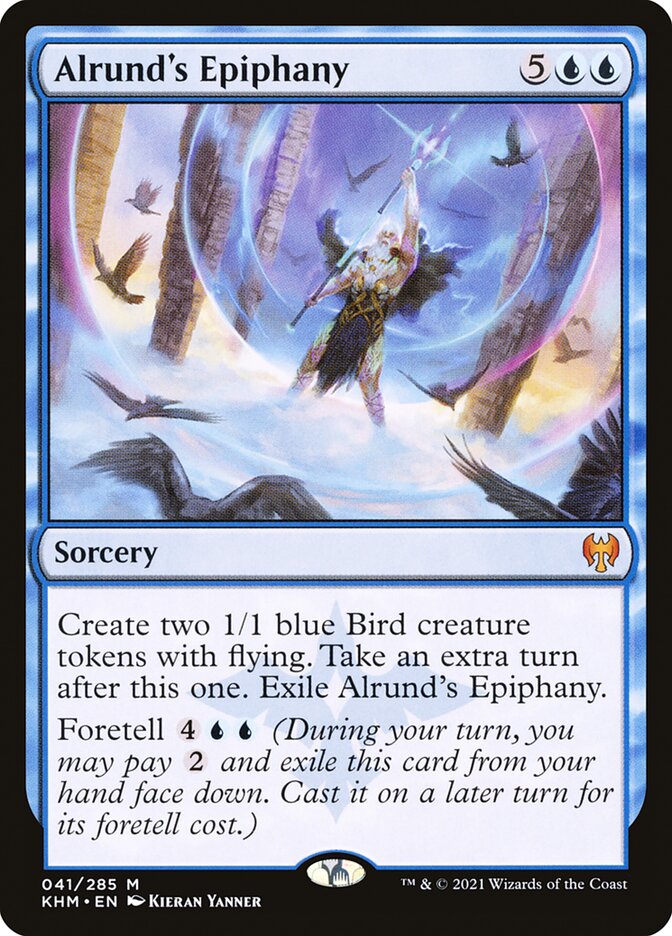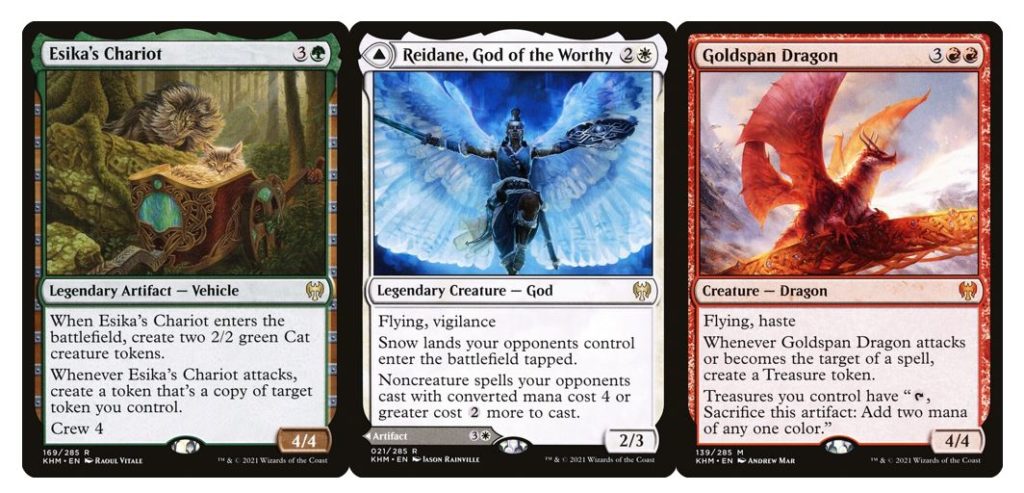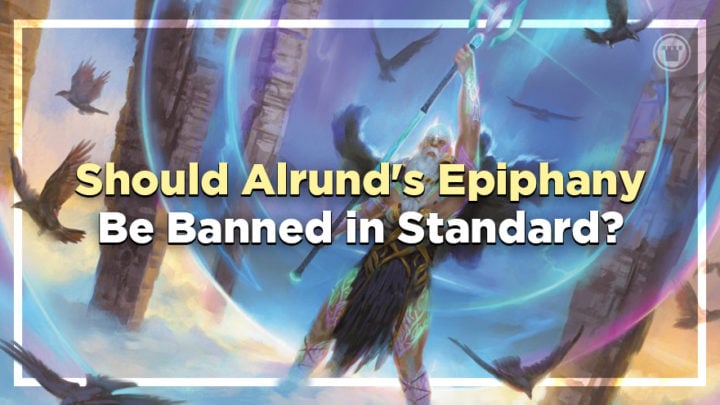With the Magic World Championship in the rear view, the one question on everyone’s mind has been, “Can any deck consistently beat Alrund’s Epiphany in Standard?” Izzet Dragons may have won the trophy, but Alrund’s Epiphany remains the biggest force to be reckoned with in the format. The calls for a ban that began long before Worlds have only intensified.
In yesterday’s B&R announcement, Wizards shared that they’ll be monitoring the format closely, but won’t be making a ban decision until after Innistrad: Crimson Vow comes out. But even with new cards entering the format, will Alrund’s Epiphany still reign supreme? What will it take to challenge its dominance?
Today, we’ll be laying out the arguments for and against banning Alrund’s Epiphany.
The Case for Banning Epiphany

Alrund’s Epiphany is powerful because it represents the absolute top end of the format. Going over the top by taking multiple extra turns in a row is a huge challenge for any deck, particularly midrange decks that are built to interact. Banning the card would prevent games from being so non-interactive and punishing for midrange decks.
As it stands, all midrange decks must have a plan for Alrund’s Epiphany, or they have to be aggressive enough to defeat the Epiphany player before their plan goes into effect. But if too many midrange decks become more aggressively-focused, the non-Epiphany decks all start to look the same. The result is a two-deck format: You’re either trying to go way over the top of everyone, or you’re trying to go underneath everyone and beat them quickly.
There’s another big reason to ban Alrund’s Epiphany, which is a tad more contentious: the play pattern isn’t fun for opponents. The games all end the same way: with one player taking a couple turns in a row and hitting you with birds. It’s a very anticlimactic way for the game to end.
I’ve covered this in previous articles, but it bears repeating: part of Magic’s beauty is that every game is different. Every game, you get a random hand with a random draw, and so does your opponent. Every turn, you get a new opportunity to draw a card that might change the tides of the battle. Taking all the turns negates this experience for one of the two players at the table. While some players do enjoy getting to do this and have the combo experience (myself included), you do have to weigh that experience against the impact it has on everyone else. Having one out of every 30 matches end in a string of turns is a lot easier to handle then one out of every two matches.
The case for banning Alrund’s Epiphany is strong. There are even more layers to this that we could dive into, like how the diversity of answers to Epiphany are all in blue, or how the foretell ability makes Epiphany even harder to answer. But I also think there’s a strong case for keeping Epiphany in the format, and I’d like to present that as well.
The Case Against Banning Epiphany

We can start with the obvious counterargument to our last point in favor of banning Epiphany: Combo decks are rarely the best decks in Standard. Combo usually either underperforms, gets hated out, or warps the format so much that a card gets banned, because no other deck can keep up with it.
Epiphany certainly isn’t underperforming, and it’s unlikely to be hated out. But it hasn’t completely pushed other decks out of the format. Mono-Green can put good pressure on the UR decks, and the white decks attack on another axis. And while UR is the most powerful thing to be doing, it does have consistency issues, and these decks that can prey on that. Are you going to forgo Dragons to beat other decks in the format? You might be sacrificing a lot against the green decks, including the ability to close the game against them before they beat you. Are you going to play several copies of Burn Down the House to beat Green? Now, you’re weak in the mirror.
Like many top decks, Epiphany isn’t invincible: it still has to adapt to what other decks are doing. The format has slightly warped around it, but that will happen in every metagame. Having a three- or four-deck Standard metagame is very common, and it isn’t inherently bad.
But here’s where things get awkward in the conversation about bannings. We’re a little more than a month out from a new set release. (Shocking, right?) With Crimson Vow coming out on Arena in just 32 days, should we even attempt to change as a new set is coming out so soon? Wizards certainly doesn’t think so.
My take is that we should assume the new set will impact the format and change the calculus for Epiphany. Wizards works far ahead in designing sets, and they make B&R designs with the advantage of foresight. It would be telling if they chose to ban Alrund’s Epiphany yesterday; if they have some card or set of cards that they think will change the metagame, we should trust them.
Conclusion
Every Magic format has a top end ceiling and a bottom floor. In months past, that ceiling was Sultai Ultimatum, and before that, it was Hydroid Krasis and Uro. Every format seemingly has a top-end deck that will apply pressure to midrange decks. Regardless of what cards are legal in the format, there will always be a “best deck.”
It’s also easy to discount new sets when the cards already in the format seem so powerful. But every time, new cards have impacted the format. Strixhaven gave us Expressive Iteration, AFR had creature lands, and there were a ton of hits in Midnight Hunt. I’m optimistic that Crimson Vow will deliver some new cards that will shake up the format, and Wizards’ decision not to ban Epiphany this week is a huge vote of confidence.
But what do you think? Do you agree with the decision not to ban Alrund’s Epiphany? Tweet at @masoneclark and let me know what you think!

Mason Clark is a grinder in every corner of the game who has played at the pro level and on the SCG Tour with Team Nova. Whether he’s competing in Standard, Historic or Modern, Mason plays with one goal in mind: to be a better player than he was the day before. Check out his podcast, Constructed Criticism, and catch his streams on Twitch.

